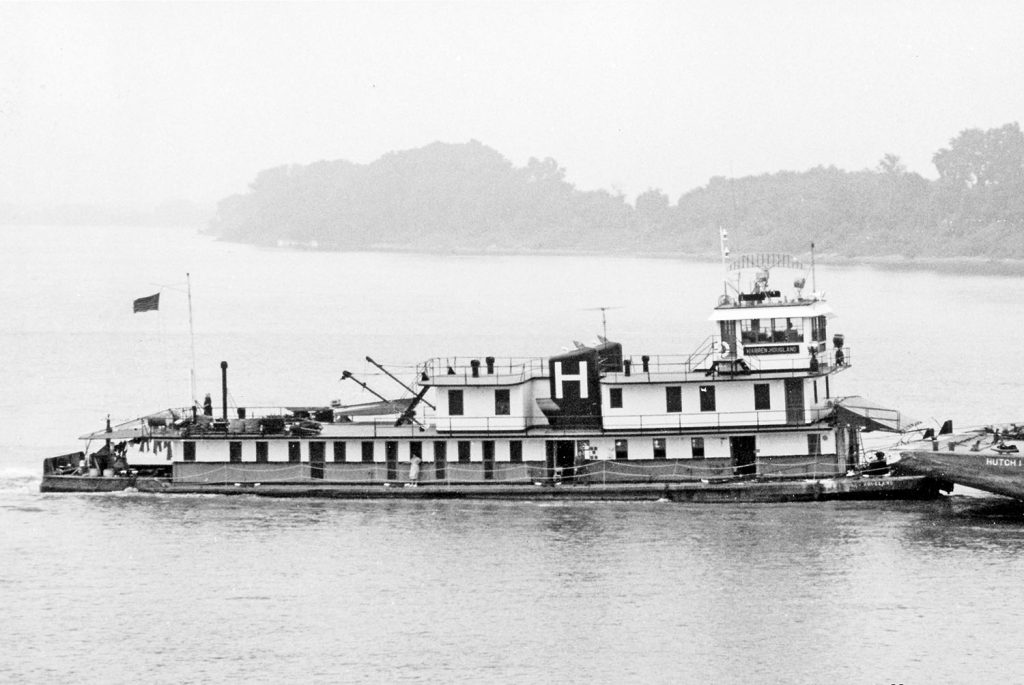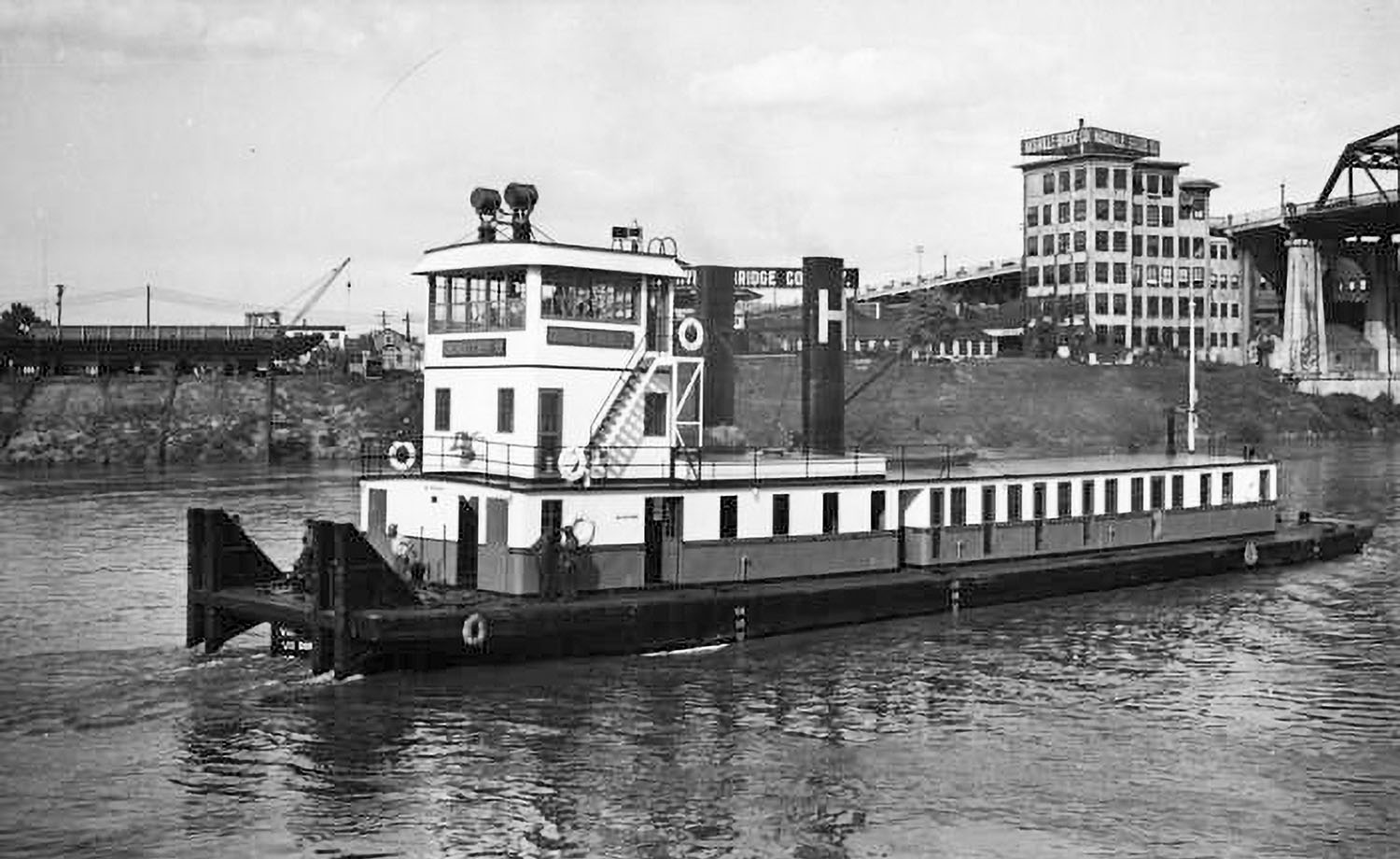In 1937, Capt. Walter G. Hougland contracted with the Nashville Bridge Company, Nashville, Tenn., for a new twin-screw diesel towboat.
The Hougland fleet at this time consisted of two steam sternwheel towboats, as well as four diesel vessels. The steamers were in layup status by the time the new boat came out in April 1938. The Bob Rodes had been built for the U.S. Engineers by Howard in 1887 as the Major Mackenzie and was later named Cherokee. It was sold to Hougland in the early 1930s and renamed. The other steamboat was the Hibernia, which had been built at Paducah in 1914. After having several owners, it was purchased by Capt. Hougland (then based at Bowling Green, Ky.), who used it in towing on the Green River.
The diesel boats were a mix of sternwheel and prop with horsepower ranging from 120 up to 350. The new boat was to be quite large in comparison, with a steel hull 143 by 30 feet (for some reason the Inland River Record listed the length as being 108.5 feet from the first edition in 1945 until 1960) and boasting 1,100 hp. from a pair of Nelseco six-cylinder, direct-drive, 19×22 diesel engines operating at 250 rpm. These details and much more were the subject of a feature story in The Waterways Journal edition of April 23, 1938.
The name selected for the boat was Dorothy H, honoring Mrs. Walter G. Hougland Jr. In addition to the main engines, there were three auxiliary engines on board. The props were 78 inches in diameter with 58-inch pitch. Two Carlisle & Finch carbon arc searchlights were mounted on top of the pilothouse, as well as a Kahlenberg Triplex “Commander” airhorn. A cabin below the pilothouse, and of identical dimensions described in the article as being 15 by 15 feet, housed a guest room. Two tall smokestacks were located aft of the second deck cabin and rose to a point slightly taller than the pilothouse.
The crew quarters, all contained within the lower cabin, were said to be “exceptionally comfortable.” The usual crew complement was to number 14, and three bathrooms were provided, “with all fittings throughout furnished by the Crane Company.” Additionally, there was “circulating hot and cold water throughout.” The galley was equipped with a WebbperfectioN oil burning range and a Frigidaire refrigerator. One “prominent boatman” was quoted as saying that the Dorothy H was “the most up-to-date, comfortable and practical diesel towboat he had ever seen.”
The Dorothy H left Nashville with “two steel barges” on April 14, 1938, picked up five barges at Paducah, dropped the two from Nashville at Cairo and arrived at St. Louis at midnight on April 17. The tow was to be loaded with gasoline at St. Louis or Wood River, and from there be delivered to Nashville. The crew on this initial trip included Capt. C. Virgil Lewis, master; Capt. Fred Lewis, pilot; Charles Bradley, chief; and W.H. Hassell, assistant engineer. Capt. Walter G. Hougland Jr. was aboard as “manager,” and Capt. Walter G. Hougland Sr. had met the boat on arrival at St. Louis.
Over the years, small changes were made to the boat. There was originally no walkway around the pilothouse. Eventually one was installed, and the searchlights were moved from on top of the pilothouse to each side of the catwalk in front of it. In 1949, the name was changed to Warren Hougland. In 1951, it was repowered with a pair of GM 12-567A diesels totaling 1,800 hp., and in 1957, it was again repowered with GM 12-567C engines, which then gave it 2,400 hp. At some point, the superstructure of the boat was rebuilt with the upper cabin extended aft to a point past the stacks, and the tall stovepipe type stacks were replaced with some of the more modern streamlined shape that Nashville Bridge was placing on towboats built there. These stacks were inset into notches in the cabin. A bulwark was also placed around the stern area.

The Warren Hougland, built in 1938, then closely resembled the Walter G. Hougland and Frances M. Hougland, built by Nashville in 1941 and 1943, respectively. These boats, dressed in the Hougland paint scheme of white cabins with a broad gray stripe on the lower portion of the main cabin and black stacks adorned with a large white “H,” were familiar sights all along the Mississippi River and tributaries until March 1973. Next week we will look at what happened at that time.
Caption for top photo: The official shipyard portrait of the Dorothy H used in Nashville Bridge Company ads in the WJ. (David Smith collection)
Capt. David Smith can be contacted at davidsmith1955obc@gmail.com.




